PARIS_FRANCE_ "The City of Light"_Part # 3 of 3

Ella Fitzgerald - I Love Paris - Woody Allen
Photo Sphere - Aug 2016:
Notre-Dame de Paris French for "Our Lady of Paris"), also known as Notre-Dame Cathedral or simply Notre-Dame, is a historic Catholic cathedral on the eastern half of the Île de la Cité in the fourth arrondissement of Paris, France. The cathedral is widely considered to be one of the finest examples of French Gothic architecture and among the largest and most well-known church buildings in the world. The naturalism of its sculptures and stained glass are in contrast with earlier Romanesque architecture.
As the cathedral of the Archdiocese of Paris, Notre-Dame is the parish that contains the cathedra, or official chair, of the archbishop of Paris, currently Cardinal André Vingt-Trois. The cathedral treasury is notable for its reliquary which houses some of Catholicism's most important first-class relics including the purported Crown of Thorns, a fragment of the True Cross, and one of the Holy Nails.
In the 1790s, Notre-Dame suffered desecration during the radical phase of the French Revolutionwhen much of its religious imagery was damaged or destroyed. An extensive restorationsupervised by Eugène Viollet-le-Duc began in 1845. A project of further restoration and maintenance began in 1991.
-VIDEO : ◄ Notre Dame de Paris, Paris [HD] ►
-2013_06_16__At the Notre Dame De Paris

Notre-Dame de Paris French for "Our Lady of Paris"), also known as Notre-Dame Cathedral or simply Notre-Dame


-2013_06_16__Notre Dame De Paris
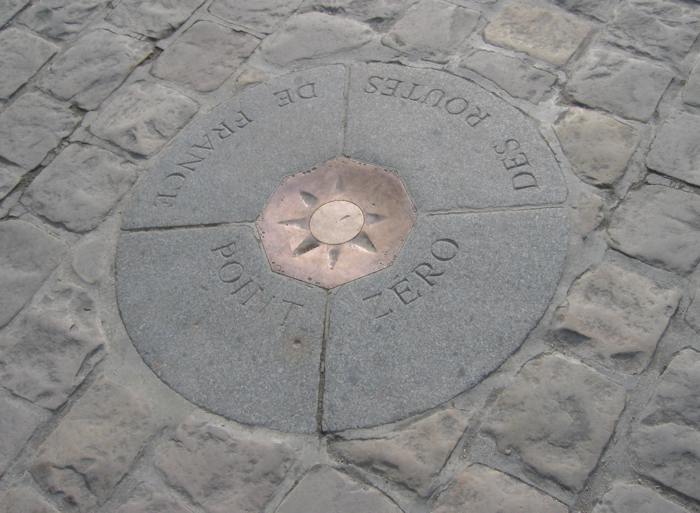
The origin of all road distances from Paris
Kilometer Zero stone, in front of Notre-Dame de Paris
Français : Point zéro des routes de France, parvis de la cathédrale Notre-Dame de Paris, France.

The north transept rose window of Notre-Dame de Paris was installed c. 1250-60 when Jean de Chelles was architect. It features the Virgin and Child enthroned in the centre, surrounded by images of kings and Old Testament prophets.

Notre Dame Cathedral, Paris - Extreme angle

Tympanum of central portal of Notre-Dame de Paris
-VIDEO :Cathedral Notre Dame de Paris_(2014)
The term comes from the French, gargouille, which means throat or gullet. This makes sense considering that water usually comes from a gargoyle’s mouth.

Gargoyle sitting on Notre Dame Cathedral and looking on Paris cityscape
There is also a French legend from the Rouen area in which a creature called la Gargouille looked like a dragon, with a long neck, bat-like wings, and the ability to breathe fire.
There are various versions of the legend, but essentially St. Romanus conquers the Gargouille with his crucifix, and brings it back to Rouen to be burned, except that its head and neck, having been tempered by its own fire, remain intact, and are then mounted on the walls of the new church to keep away evil spirits.

Gargoyle sitting on Notre Dame Cathedral contemplating the Paris cityscape
-VIDEO :PBS - Cathedral - David Macaulay
The spire and east side of the cathedral.
-VIDEO :Tour of Notre Dame Cathedral - Pagan Symbolism
The new bells of Notre-Dame de Paris Cathedral on public display in the nave in February 2013
-VIDEO :Cathédrale Notre-Dame de Paris (Full HD)

Notre-Dame's high altar with the kneeling statues of Louis XIII and Louis XIV.
 The Statue of Virgin and Child inside Notre-Dame de Paris
The Statue of Virgin and Child inside Notre-Dame de Paris

-VIDEO :Notre Dame de Paris ,France ( Full HD )

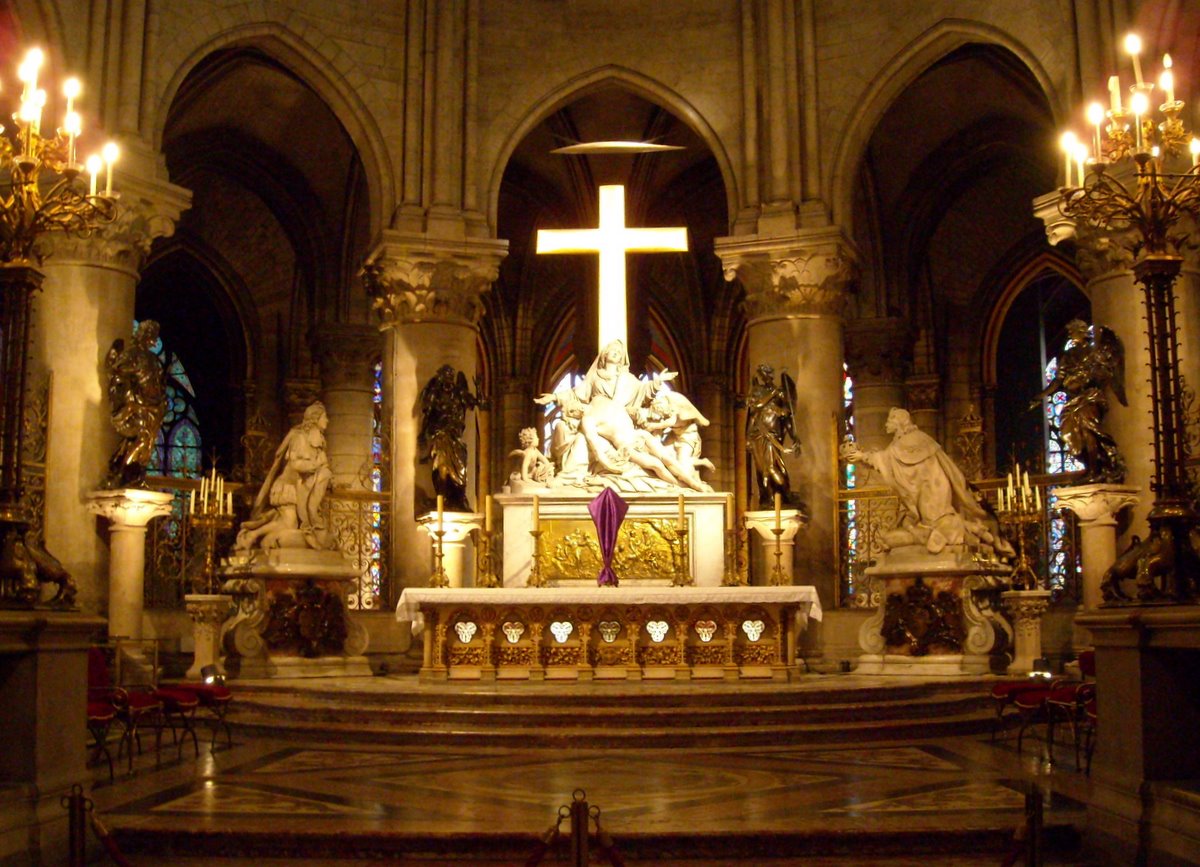
Chœur de Notre-Dame de Paris : Pieta de Nicolas Coustoues et de part et d'autre, statues de Louis XIII par Guillaume Coustou et Louis XIV sculpté par Antoine Coysevox
.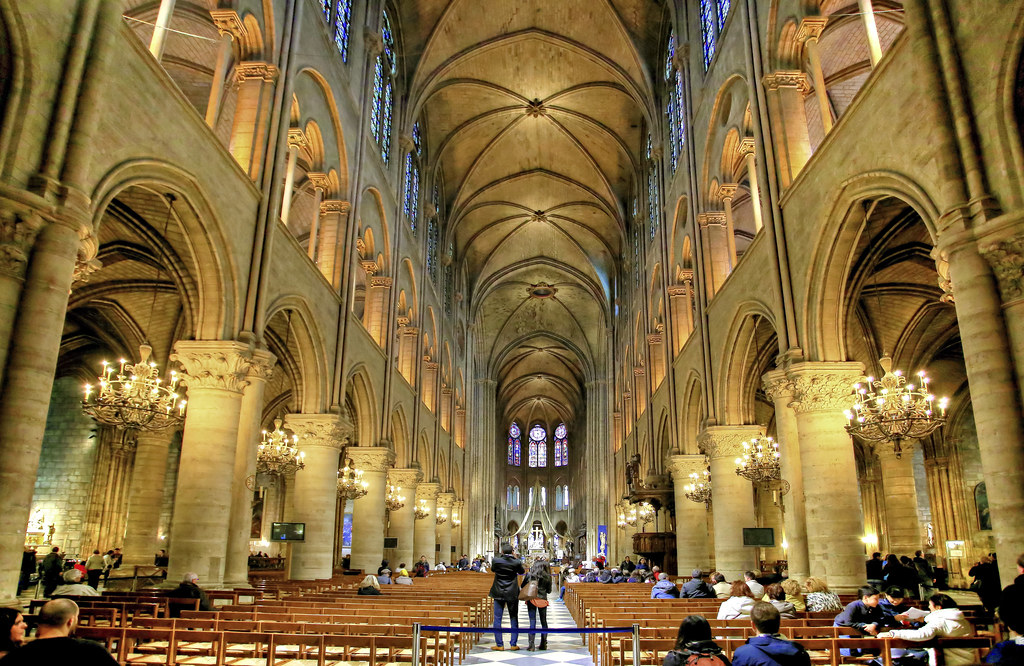

Notre-Dame de Paris (1160 - 1260)_360 VISIO :
- Grand medieval Cathedral in the heart of Paris. With 13 million visitors yearly,
it is the most visited monument in Europe and the most famous gothic building worldwide.
Notre Dame is a very old cathedral in Paris, France. It is one of France's most famous landmarks and many people visit it each year. The cathedral is on a small island on the River Seine. It is the cathedral of the Catholic Archdiocese of Paris, one of 23 archdioceses in France. The cathedral was built during two centuries. It is a very good example of Gothic Architecture in France. At the time it was finished, the cathedral was the biggest such building in Western Europe. Between 1844 and 1864, the building was renovated under the direction of Eugène Viollet-le-Duc, who incorporated elements into the design that the medieval building had not possessed before. The two rose windows which ornate the transept are among the biggest in Europe: each has a diameter of 13m.
The bronze plate in the parvis before the cathedral is the origin of all road distances in France calculated from Paris. The national geographic institute in France uses the building as a benchmark. The coordinates and altitude for this point are known precisely.
Victor Hugo wrote a famous story. The story takes place around the cathedral. The English title is 'The Hunchback of Notre Dame', but in French it is called 'Notre-Dame de Paris'.
Tradition has it that Notre-Dame’s first stone was laid in 1163 in the presence of Pope Alexander III.A wide angle view of Notre-Dame's western facade
-VIEW :Notre-Dame de Paris - Visite à 360° VR de la cathédrale_
Visitez en réalité virtuelle à 360° la cathédrale Notre-Dame de Paris filmée avant le terrible incendie ce lundi 15 avril 2019. Images exclusives tournées en février 2019 pour TV5MONDE et Le Forum des images.
-VIDEO :NOTRE DAME DE PARIS - June 2017. 4K-UHD.


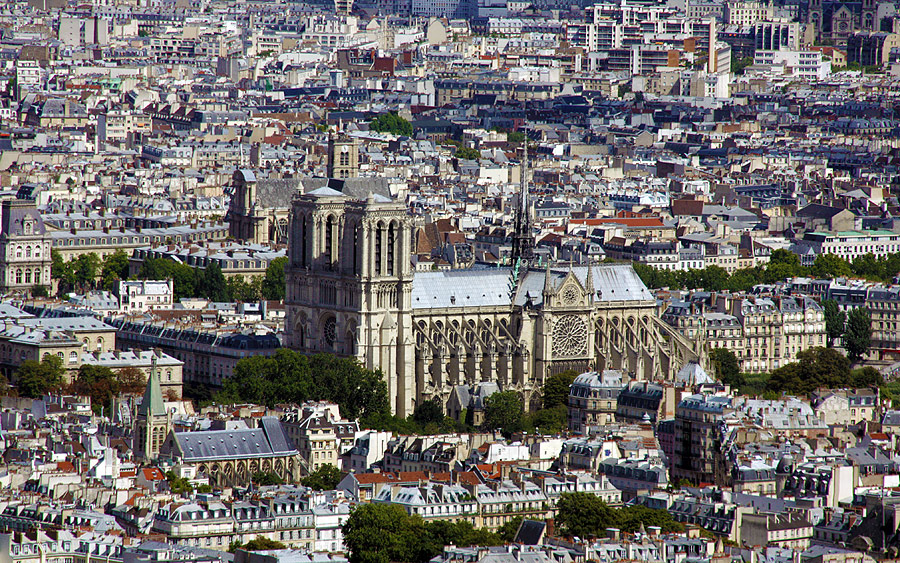
Remote view of Notre-Dame de Paris seen from Montparnasse Tower
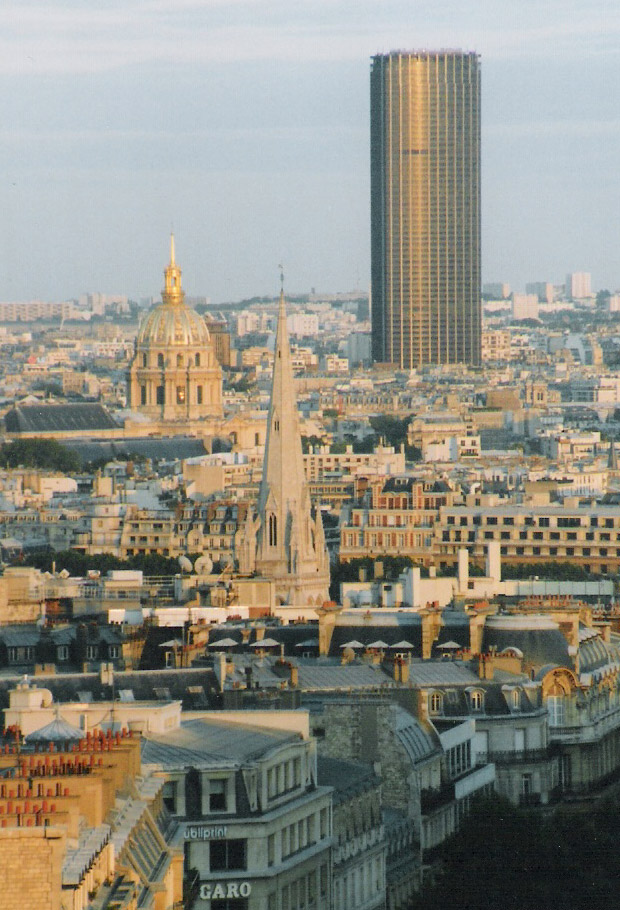
Tour Maine-Montparnasse (Maine-Montparnasse Tower), also commonly named Tour Montparnasse, is a 210-metre (689 ft) office skyscraper located in the Montparnasse area of Paris,France. Constructed from 1969 to 1973, it was the tallest skyscraper in France until 2011, when it was surpassed by the 231 m (758 ft) Tour First. As of February 2015, it is the 17th tallest building in the European Union. The tower was designed by architects Eugène Beaudouin, Urbain Cassan and Louis Hoym de Marien and built by Campenon Bernard

Tower seen from Jardins du Luxembourg

Montparnasse next to Eiffel Tower

Montparnasse seen from Eiffel Tower

Inauguration of the First Tower at La Defense, Paris. At the time of the shot the highest skyscraper in France (231m).
Tour First (previously known as Tour UAP between 1974-1998, and as Tour AXA between 1998-2007) is an office skyscraper in Courbevoie, in La Défense, the business district of the Paris metropolitan area.
The tower was built in 1974 by Bouygues for the UAP insurance company. The building was 159 m (522 ft) at that time. Its ground shape was in the form of a three-pointed star whose branches were separated each by a 120° angle. This particular shape was chosen to symbolize the merger of the three French insurance companies that were at the origin of UAP. The tower was renamed Tour AXA when UAP was bought by the AXA insurance company in 1996.
Large-scale renovation of the tower began in 2007 and was completed in 2011. The exterior appearance of the building was completely changed, with extra height added to the tower. The renovated tower, now known as Tour First, is 225 m (738 ft) at roof height, and 231 m (758 ft) including its spire, with a total floor space of 86,707 m2 (933,310 sq ft). It is currently the tallest skyscraper in France, only surpassed in height by the Eiffel Tower (The Eiffel tower is 324 metres (1,063 ft) tall, about the same height as an 81-storey building)
Another AXA tower exists in New York City, which is 229 m (751 ft) tall; Tour AXA in Montreal, Canada was completed in 1974 and is 104 m (341 ft).
The coronation of Napoleon I on 2 December 1804 at Notre-Dame in an 1807 painting byJacques-
Louis David.

Louis David.
The coronation of Napoleon I on 2 December 1804 at Notre-Dame in an 1807 painting byJacques-
Louis David.
Louis David.
movie :"Notre Dame de Paris 1956 "
Enrico Macias - Zingarella
-MOVIE :The Hunchback of Notre Dame 1997
-READ :Notre Dame de Paris _Victor Marie Hugo (1802-1885).pdf (English)Hugo's novel Notre-Dame de Paris (The Hunchback of Notre-Dame) was published in 1831 and quickly translated into other languages across Europe. One of the effects of the novel was to shame the City of Paris into restoring the much-neglected Cathedral of Notre Dame, which was attracting thousands of tourists who had read the popular novel. The book also inspired a renewed appreciation for pre-Renaissance buildings, which thereafter began to be actively preserved.
-LIRE :NOTRE-DAME DE PARIS (1831)_Victor Hugo.pdf (French)

The Paris Opera at Rush Hour

2009-06-04_@ the Opera House,Pari

South facade of the Opéra Garnier in Paris, France.
Main facade
The principal facade is on the south side of the building, overlooking the Place de l'Opéra and terminates the perspective along the Avenue de l'Opéra. Fourteen painters, mosaicists and seventy-three sculptors participated in the creation of its ornamentation.
The two gilded figural groups, Charles Gumery's L'Harmonie (Harmony) and La Poésie (Poetry), crown the apexes of the principal facade's left and right avant-corps. They are both made of gilt copper electrotype.
The bases of the two avant-corps are decorated (from left to right) with four major multi-figure groups sculpted by: François Jouffroy (Poetry, also known as Harmony), Jean-Baptiste Claude Eugène Guillaume (Instrumental Music), Jean-Baptiste Carpeaux (The Dance, criticized for indecency), and Jean-Joseph Perraud (Lyrical Drama). The facade also incorporates other work by Gumery, Alexandre Falguière, and others.
Gilded galvanoplastic bronze busts of many of the great composers are located between the columns of the theatre's front façade and depict from left to right: Rossini, Auber, Beethoven, Mozart, Spontini, Meyerbeer, and Halévy. On the left and right lateral returns of the front facade are busts of the librettists Eugène Scribe and Philippe Quinault, respectively.
Stage flytower
The sculptural group Apollo, Poetry, and Music, located at the apex of the south gable of the stage flytower, is the work of Aimé Millet, and the two smaller bronze Pegasus figures at either end of the south gable are by Eugène-Louis Lequesne.
Photo Sphere - Aug 2016:
-VIDEO :Palais Garnier/Opera National de Paris Documentary
The Paris Opera (French: Opéra de Paris) is the primary opera company of France. It was founded in 1669 by Louis XIV as the Académie d'Opéra, and shortly thereafter was placed under the leadership of Jean-Baptiste Lully and officially renamed the Académie Royale de Musique, but continued to be known more simply as the Opéra. Classical ballet as we know it today arose within the Paris Opera as the Paris Opera Ballet and has remained an integral and important part of the company. Currently called the Opéra National de Paris, it mainly produces operas at its modern 2700-seat theatre Opéra Bastille which opened in 1989, and ballets and some classical operas at the older 1970-seat Palais Garnierwhich opened in 1875. Small scale and contemporary works are also staged in the 500-seat Amphitheatre under the Opéra Bastille.
The company's annual budget is in the order of 200 million euros, of which 100 million come from the French state and 70 million from box office receipts. With this money, the company runs the two houses and supports a large permanent staff, which includes the orchestra of 170, a chorus of 110 and the corps de balletof 150.
Each year, the Opéra presents about 380 performances of opera, ballet and other concerts, to a total audience of about 800,000 people (of which 17% come from abroad), which is a very good average seat occupancy rate of 94%. In the 2012/13 season, the Opéra presents 18 opera titles (two in a double bill), 13 ballets, 5 symphonic concerts and two vocal recitals, plus 15 other programmes. The company's training bodies are also active, with 7 concerts from the Atelier Lyrique and 4 programmes from the École de Danse.
Le Grand Foyer, at the Palais Garnier
Inauguration of the Paris Opera, 5 January 1875
-Masquerade_from the 2004 film version of The Phantom of the Opera :
Opera_Garnier_Grand_Escalier.
The Grand Staircase leading to the room, lounges and lobby in 1877 by Louis Beroud
-VIEW : VIRTUAL TOUR :Inside Palais Garnier – The Paris Opera House
-MOVIE :The Phantom of the Opera (2004)_
-VIDEO :Xem Phim Bóng Ma Trong Nhà Hát – The Phantom of the Opera at the Royal Albert Hall 2011 Vietsub
Galeries Lafayette, Paris
Street View Apr 2017.

The Galeries Lafayette is an upmarket French department store chain. Its flagship store is on Boulevard Haussmannin the 9th arrondissement of Paris but it now operates in a number of other locations in France and other countries. In 2009, Galeries Lafayette recorded earnings of over one billion euro. It is a part of the company Groupe Galeries Lafayette.

2009-06-04_A selfie @ the Galeries Lafayette, Paris
Street View_Aug 2013.

-VIDEO :Paris: Galeries Lafayette and Printemps

PRINTEMPS HAUSSMANN
Depuis la terrasse du Printemps Haussmann
The Sorbonne University is the historic soul of the Latin Quarter, in Paris, where higher learning has flourished for centuries. Founded in 1257 for a small group of theology students, the Sorbonne is one of Europe’s oldest universities. It has hosted countless great thinkers, including philosophers Ren
French University: Campus Sorbonne PARIS | by eagle1effi
 Place de la Bastille with the July Column in its center.
Place de la Bastille with the July Column in its center.

The storming of the Bastille on 14 July 1789, marked the beginning of the French Revolution, and freed its seven prisoners, by Jean-Baptiste Lallemand, Carnavalet Museum

-VIDEO :Eglise Saint Eustache Paris (Full HD
Plus de 200 vidéos HD sur Paris gratuites et en ligne sur http://www.toutparisenvideo.com
The Sorbonne University is the historic soul of the Latin Quarter, in Paris, where higher learning has flourished for centuries. Founded in 1257 for a small group of theology students, the Sorbonne is one of Europe’s oldest universities. It has hosted countless great thinkers, including philosophers Ren
French University: Campus Sorbonne PARIS | by eagle1effi
-VIDEO :Histoire de la Sorbonne
-VIDEO :DRDA : La Sorbonne côté coulisses
The Latin Quarter of Paris (French: Quartier latin) is an area in the 5th and the 6th arrondissements of Paris. It is situated on the left bank of the Seine, around theSorbonne.
Known for its student life, lively atmosphere and bistros, the Latin Quarter is the home to a number of higher education establishments besides the university itself, such as the Lang-Martinez Psychiatric Hospital, the École des Mines de Paris, Panthéon-Assas University, theSchola Cantorum, and the Jussieu university campus. Other establishments such as theÉcole Polytechnique have relocated in recent times to more spacious settings.
The area gets its name from the Latin language, which was once widely spoken in and around the University since Latin was the language of learning in the Middle Ages in Europe.
-VIDEO :Latin Quarter of Paris

The storming of the Bastille on 14 July 1789, marked the beginning of the French Revolution, and freed its seven prisoners, by Jean-Baptiste Lallemand, Carnavalet Museum

-VIDEO :Eglise Saint Eustache Paris (Full HD
-VIEW : Plus de 200 vidéos HD gratuites.
L'Eglise Saint-Eustache est une des églises les plus visités de Paris. Déjà considéré comme un des plus beaux monuments religieux de la capitale... grâce à la richesse des œuvres d'art qu'elle abrite ("Martyre de saint Eustache" par Vouet ou "statue de la Vierge" par Pigalle), l'Eglise Saint-Eustache se distingue aussi par ses dimensions hors norme (33 m de haut, 100 m de long et 43 m de large) qui le rapproche davantage d'une cathédrale.
Des immenses dimensions qui permettent à cet édifice symbole du quartier des Halles d'offrir à ces auditeurs, une qualité acoustique rare.
Autour de son organiste titulaire vedette, Jean Guillou, l'Eglise Saint-Eustache organise toute l'année des concerts où on peut entendre des orchestres symphoniques, des musiques de Chambre... et bien sur, le fameux Chœur de Saint-Eustache.
The Hôtel-Dieu de Paris, the oldest hospital in the city.
-VIDEO :La Défense, Paris_(2011)

Skyscrapers of La Défense seen from the Saint-Jacques Tower in central Paris
La Défense is a major business district of the Paris Metropolitan Area and of the Île-de-France region, located in the commune of Courbevoie, and parts ofPuteaux and Nanterre, just west of the city of Paris.
La Défense is Europe's largest purpose-built business district with 560 hectares (5.6 million square metres) area, 72 glass and steel buildings of which 18 are completed skyscrapers, 180,000 daily workers, and 3.5 million square metres (37.7 million sq ft) of office space. Around its Grande Arche and esplanade ("le Parvis"), La Défense contains many of the Parisurban area's tallest high-rises.
The district is located at the westernmost extremity of the ten-kilometre-long Historical Axis of Paris, which starts at the Louvre in Central Paris, and continues along the Champs-Élysées, well beyond the Arc de Triomphe along the Avenue de la Grande Armée before culminating at La Défense. The district is centred in an orbital motorway straddling the Hauts-de-Seine département municipalities of Courbevoie, Nanterre and Puteaux. La Défense is primarily a business district, and hosts only a population of 25,000 permanent residents and 45,000 students. La Défense is also visited by 8,000,000 tourists each year, and houses an open-air museum

Statue of La Défense de Paris which commemorates the Parisian resistance during the Franco-Prussian War.La Défense business district, Paris.
The Musée d'Orsay is a museum in Paris, France, on the left bank of the Seine. It is housed in the former Gare d'Orsay, a Beaux-Artsrailway station built between 1898 and 1900. The museum holds mainly French art dating from 1848 to 1915, including paintings, sculptures, furniture, and photography. It houses the largest collection of impressionist and post-impressionist masterpieces in the world, by painters including Monet, Manet, Degas, Renoir, Cézanne, Seurat,Sisley, Gauguin and Van Gogh. Many of these works were held at the Galerie nationale du Jeu de Paume prior to the museum's opening in 1986.

North side of Orsay Museum building. This panorama is made of three pictures stitched with Hugin.

The Musée d'Orsay as seen from the Passerelle Léopold-Sédar-Senghor
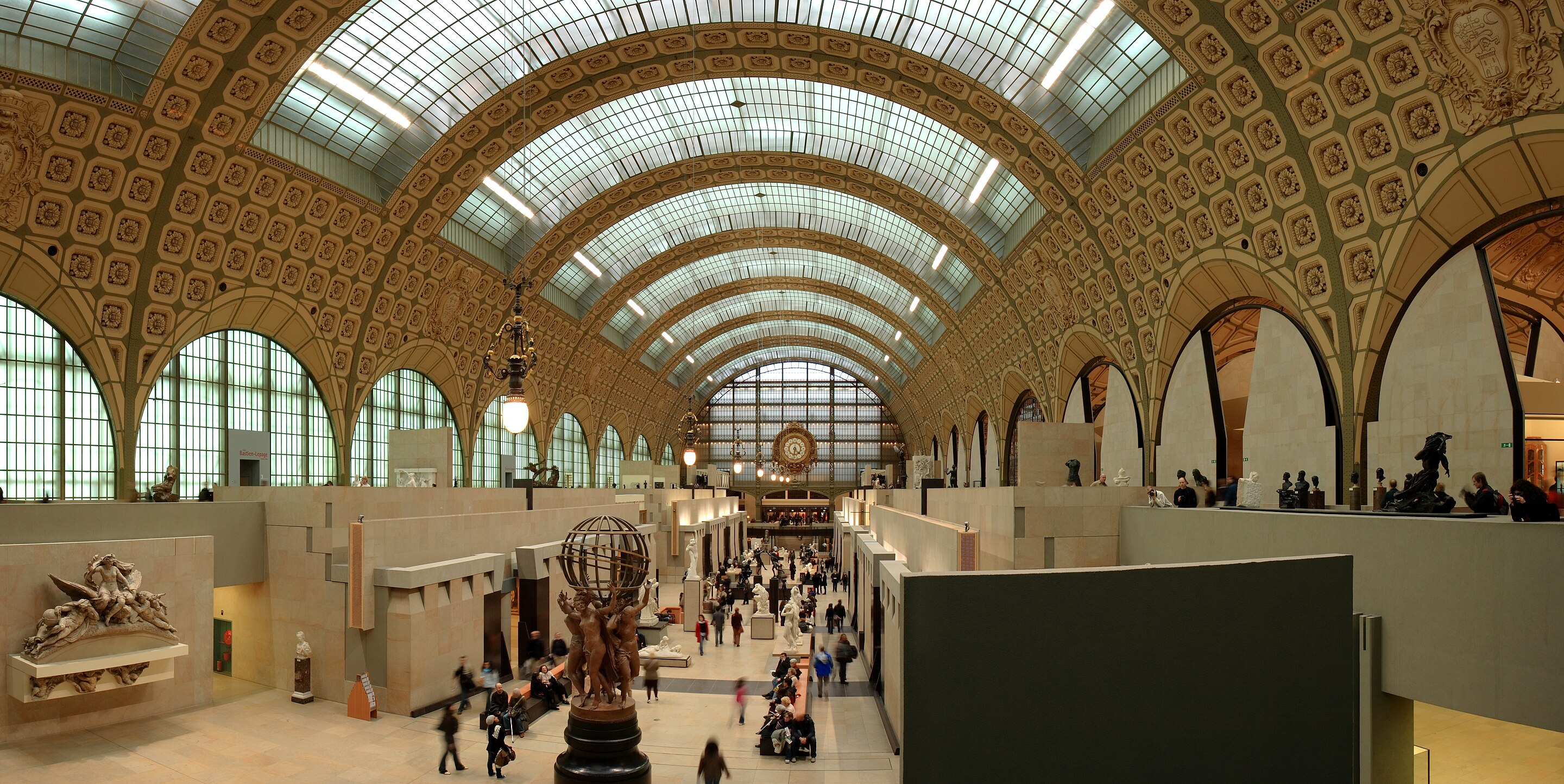
Main alley of the Orsay Museum in Paris, France.
-VIDEO :Paris, France: Orsay Museum(2015)The Orsay Gallery, famous for its much-loved collection of Impressionist masterpieces, fills a magnificent building once used as a train station with art from 1848 to 1914. Old World meets the modern world in these halls, resulting in conservative and revolutionary pieces side by side.
-VIDEO :L'impressionnisme, éloge de la mode (ARTE/Musée d'Orsay)
-VIDEO :Rick Steves France Playlist
-VIEW :Performance Artist Does Impromptu Reenactment Of 'The Origin Of The World.' Yes, THAT Painting.(L'Origine du monde ("The Origin of the World") is an oil-on-canvas painted by French artist Gustave Courbet in 1866.)
-VIDEO :THE ART OF IMPRESSIONISM - DOCUMENTARY 2016 HISTORY CHANNEL
-VIDEO :The Impressionists Part 1_BBC
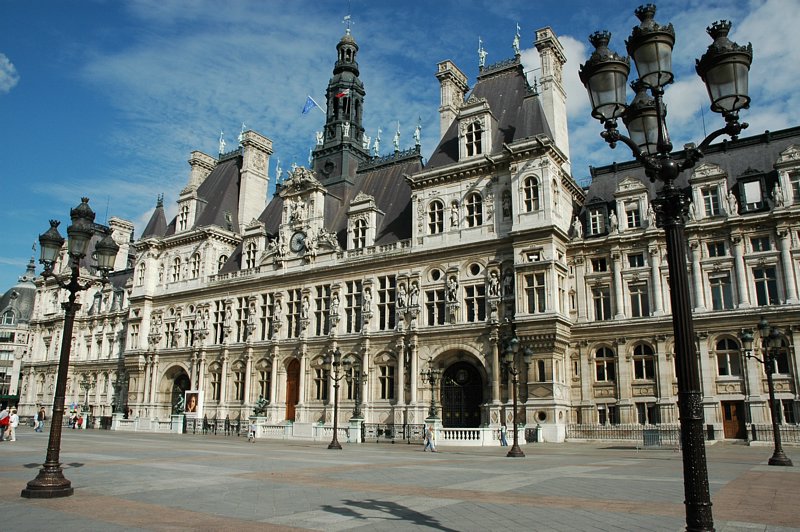
The Hôtel de Ville ( City Hall) in Paris, France, is the building housing the city's local administration. Standing on the place de l'Hôtel-de-Ville (formerly place de Grève) in the 4th arrondissement, it has been the location of the municipality of Paris since 1357. It serves multiple functions, housing the local administration, the Mayor of Paris (since 1977), and also serves as a venue for large receptions.
-VIDEO :Modern Art at Pompidou Center - Paris 2013
-VIDEO :Hotel de ville de Paris
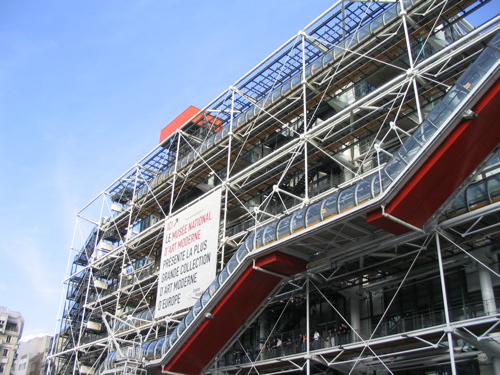
Centre Georges Pompidou ; commonly shortened to Centre Pompidou; also known as the Pompidou Centre in English) is a complex building in the Beaubourg area of the 4th arrondissement of Paris, near Les Halles, rue Montorgueil and the Marais. It was designed in the style of high-tech architecture by the architectural team of Richard Rogers and Renzo Piano, along with Gianfranco Franchini.
It houses the Bibliothèque publique d'information (Public Information Library), a vast public library, the Musée National d'Art Moderne, which is the largest museum for modern art in Europe, and IRCAM, a centre for music and acoustic research. Because of its location, the Centre is known locally as Beaubourg . It is named after Georges Pompidou, thePresident of France from 1969 to 1974 who commissioned the building, and was officially opened on 31 January 1977 by President Valéry Giscard d'Estaing. As of 2006, the Centre Pompidou has had over 180 million visitors since 1977 and more than 5,209,678 visitors in 2013, including 3,746,899 for the museum.
The sculpture, Horizontal by Alexander Calder, a free-standing mobile that is twenty-five feet high (7.6m), was placed in 2012 in front of the Centre Pompidou.
-MOVIE : Midnight in Paris (2011)_vietsub_
While on a trip to Paris with his fiancée's family, a nostalgic screenwriter finds himself mysteriously going back to the 1920s every day at midnight.
-Paris When It Sizzles :
-THE LAST TIME I SAW PARIS (1954) - Full Movie - Captioned :
-MOVIE :THE LAST TIME I SAW PARIS (1954) - Full Movie - Captioned
While covering the V-E Day celebration in Paris, a reporter meets and falls in love with a wealthy American girl. He squanders his writing talent and his wealth from a Texas oil well and loses the love of his life in the process. Based on F. Scott Fitzgerald's "Babylon Revisited." Public domain film.
-MOVIE :AN AMERICAN IN PARIS - 1951.

Three friends struggle to find work in Paris. However, things become more complicated when two of them fall in love with the same woman.
-French Kiss (1995) :




-Gare de Lyon_(1910)_Eugène Galien-Laloue

A panoramic view of the Gare de Lyon train station in Paris_Inside the station
-VIDEO : Paris: Gare de Lyon
I love this station, mainly because Le Train Bleu Restaurant is there. This restaurant is one of the most beautiful restaurants in the world and always a must see place when in Paris. This station always seems to be active and alive with people coming and going at all times. Even if you are not arriving or traveling anywhere by train, Gare de Lyon is a must see on your tour of Paris. At the time I filmed Gare de Lyon it was almost Christmas time so the station was all tarted-out for the holiday season.
Paris-Gare de Lyon (or Gare de Lyon) is one of the six large mainline railway station termini in Paris, France. It handles about 90,000,000 passengers every year, making it the third busiest station of France and one of the busiest of Europe. It is the northern terminus of the Paris–Marseille railway. It is named after the city of Lyon, a stop for many long-distance trains departing here, most en route to the south of France. The station is located in the 12th arrondissement, on the north bank of the river Seine, in the east of Paris.
The station is served by high-speed TGV trains to south and eastern France, Switzerland, Germany, Italy and Spain. The station also hosts regional trains and the RER and also by the Gare de Lyon metro station.
The station was built for the World Exposition of 1900. On multiple levels, it is considered a classic example of the architecture of its time. Most notable is the large clock tower atop one corner of the station, similar in style to the clock tower of the United Kingdom Houses of Parliament, home to Big Ben.
The station houses the Le Train Bleu restaurant, which has served drinks and meals to travellers and other guests since 1901 in an ornately-decorated setting.
On 27 June 1988, in the Gare de Lyon train accident, a runaway train crashed into a stationary rush-hour train, killing 56 people and injuring a further 55.
 -Paris Marriott Rive Gauche Hotel & Conference Center
-Paris Marriott Rive Gauche Hotel & Conference Center
Paris-Gare de Lyon (or Gare de Lyon) is one of the six large mainline railway station termini in Paris, France. It handles about 90,000,000 passengers every year, making it the third busiest station of France and one of the busiest of Europe. It is the northern terminus of the Paris–Marseille railway. It is named after the city of Lyon, a stop for many long-distance trains departing here, most en route to the south of France. The station is located in the 12th arrondissement, on the north bank of the river Seine, in the east of Paris.
The station is served by high-speed TGV trains to south and eastern France, Switzerland, Germany, Italy and Spain. The station also hosts regional trains and the RER and also by the Gare de Lyon metro station.
The station was built for the World Exposition of 1900. On multiple levels, it is considered a classic example of the architecture of its time. Most notable is the large clock tower atop one corner of the station, similar in style to the clock tower of the United Kingdom Houses of Parliament, home to Big Ben.
The station houses the Le Train Bleu restaurant, which has served drinks and meals to travellers and other guests since 1901 in an ornately-decorated setting.
On 27 June 1988, in the Gare de Lyon train accident, a runaway train crashed into a stationary rush-hour train, killing 56 people and injuring a further 55.
2013-06-14_In Paris,France
-Palace of Versailles :
The Palace of Versailles or simply Versailles, is a royal château in Versailles in the Île-de-France region of France. In French it is the Château de Versailles.
When the château was built, Versailles was a country village; today, however, it is a wealthy suburb of Paris, some 20 kilometres southwest of the French capital. The court of Versailles was the center of political power in France from 1682, when Louis XIV moved from Paris, until the royal family was forced to return to the capital in October 1789 after the beginning of the French Revolution. Versailles is therefore famous not only as a building, but as a symbol of the system of absolute monarchy of the Ancien Régime.

The Palace of Versailles

2013.04.22 Panorama

The Palace of Versailles
The earliest mention of the name of Versailles is in a document dated 1038, relating to the village of Versailles. In 1575, the seigneury of Versailles was bought by Albert de Gondi, a naturalized Florentine, who invited Louis XIII on several hunting trips in the forests surrounding Versailles. Pleased with the location, Louis ordered the construction of a hunting lodge in 1624. Eight years later, Louis obtained the seigneury of Versailles from the Gondi family and began to make enlargements to the château. This structure would become the core of the new palace. Louis XIII's successor, Louis XIV, had it expanded into one of the largest palaces in the world.Following the Treaties of Nijmegen in 1678, he began to gradually move the court to Versailles. The court was officially established there on 6 May 1682.
After the disgrace of Nicolas Fouquet in 1661, Louis confiscated Fouquet's estate and employed the talents of Le Vau, Le Nôtre, and Le Brun, who all had worked on Fouquet's grand château Vaux-le-Vicomte, for his building campaigns at Versailles and elsewhere. For Versailles, there were four distinct building campaigns
2013.04.22 Panorama
-VIDEO :Histoire du château de Versailles
View of the Palace from the garden
-Versailles Travel Video Guide :

Palace of Versailles
Aerial view of the Palace of Versailles-VIDEO :Discover Palace of Versailles [documentary] (en)

View of the Chateau de Versailles from the Grand Canal


-VIDEO :The Rise and Fall of Versailles (part # 1+2)
-VIDEO :The Rise and Fall of Versailles Part 3 of 3
Versailles

Panoramic view from the park
Château de Versailles




Louis XIV (5 September 1638 – 1 September 1715), known as Louis the Great (Louis le Grand) or the Sun King (le Roi-Soleil), was a monarch of the House of Bourbon who ruled as King of France from 1643 until his death. His reign of 72 years and 110 days is the longest of any monarch of a major country in European history.
Louis began his personal rule of France in 1661 after the death of his chief minister, the Italian Cardinal Mazarin. An adherent of the concept of the divine right of kings, which advocates the divine origin of monarchical rule, Louis continued his predecessors' work of creating a centralized state governed from the capital. He sought to eliminate the remnants of feudalism persisting in parts of France and, by compelling many members of the nobility to inhabit his lavish Palace of Versailles (formerly a hunting lodge belonging to Louis's father), succeeded in pacifying the aristocracy, many members of which had participated in the Fronde rebellion during Louis's minority. By these means he became one of the most powerful French monarchs and consolidated a system of absolute monarchical rule in France that endured until the French Revolution.
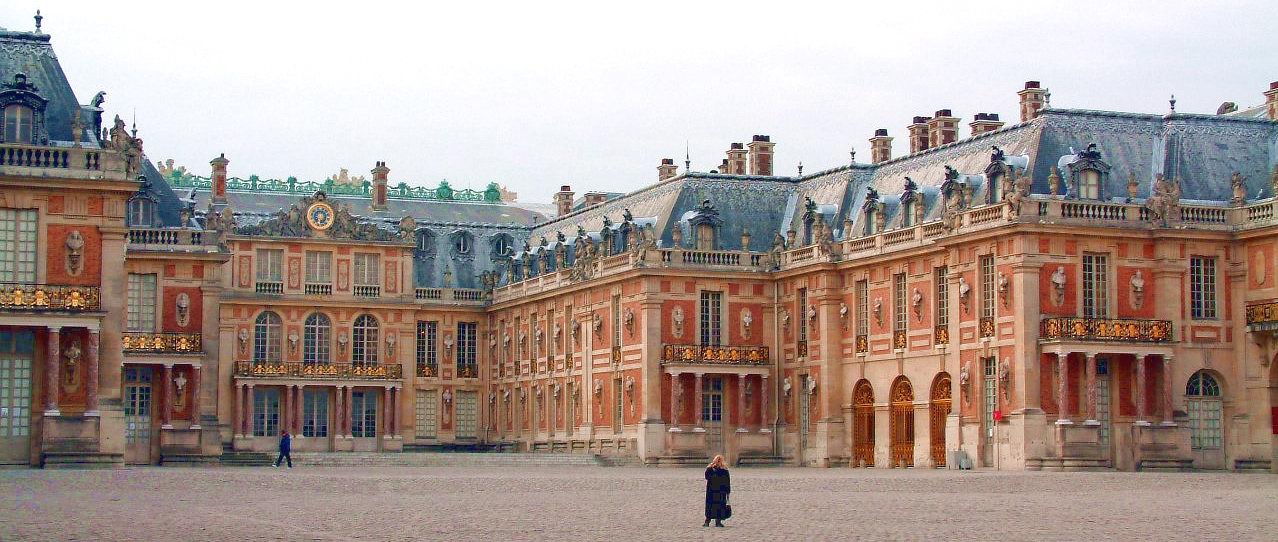
The Cour royale and the Cour de marbre at Versailles
Louis converted a hunting lodge built by Louis XIII into the spectacular Palace of Versailles. With the exception of the current Royal Chapel (built near the end of Louis's reign), the palace achieved much of its current appearance after the third building campaign, which was followed by an official move of the royal court to Versailles on 6 May 1682.
Versailles became a dazzling, awe-inspiring setting for state affairs and the reception of foreign dignitaries. At Versailles, the king alone commanded attention. Several reasons have been suggested for the creation of the extravagant and stately palace, as well as the relocation of the monarchy's seat.

View of the Palace from the garden

A row of statues in the Versailles Garden





Apollo Fountain, Versailles





Apollo Fountain, Versailles

Bassin de Latone, Versailles

Ceres Fountain, Versailles

Deux Amours et une Fillette

Dragon Fountain, Versailles

The Neptune Basin has many fantastic fountains and sculptures. Is this Apollo, symbol of the sun, riding a swan?
The Neptune Basin has many fantastic fountains and sculptures. Is this Apollo, symbol of the sun, riding a swan?

La Garonne, Versailles



Le Buffet d'Eau, Garden of the Grand Trianon, Versailles

La France Triomphant

Neptune Fountain, Versailles

Putti Statues at the Parterre d'eau, Versailles

Pyramid Fountain, Versailles

Sculpture at Versailles

Statue of the Sun King

Putti Statues at the Parterre d'eau, Versailles

Pyramid Fountain, Versailles

Sculpture at Versailles

Statue of the Sun King

Equestrian statue of Louis XIV at Versailles






Facade of the Versailles Palace

Chateau de Versaille

The Main Palace at Versailles

Palace of Versaille


Royal Chapel, Versailles Palace

Chapel, Palace of Versailles



Temple of Love at the English Garden, Petit Trianon, Versailles

Chateau de Versaille

The Main Palace at Versailles

Palace of Versaille


Royal Chapel, Versailles Palace

Chapel, Palace of Versailles



Temple of Love at the English Garden, Petit Trianon, Versailles

Formal garden at the Versailles Palace

Lighthouse tower in Marie Antoinette

Lighthouse tower in Marie Antoinette

Formal garden at the Versailles Palace

The Orangerie of Versailles

Versailles garden

Versailles

The Orangerie of Versailles

Versailles garden

Versailles


Versailles Palace and garden

Versailles courtyard

Versailles Palace

Gilded gate at the Versailles Palace

Hall of Mirrors, Versailles

Hall of Mirrors, Versailles

Galerie des Cotelle, Grand Trianon, Versailles

The_Grand_

Statue of King Louis XIV, Venus Room, Versailles

Grand Trianon loggia

The_Grand_

Statue of King Louis XIV, Venus Room, Versailles

Grand Trianon loggia


Ornate door in the Venus Room
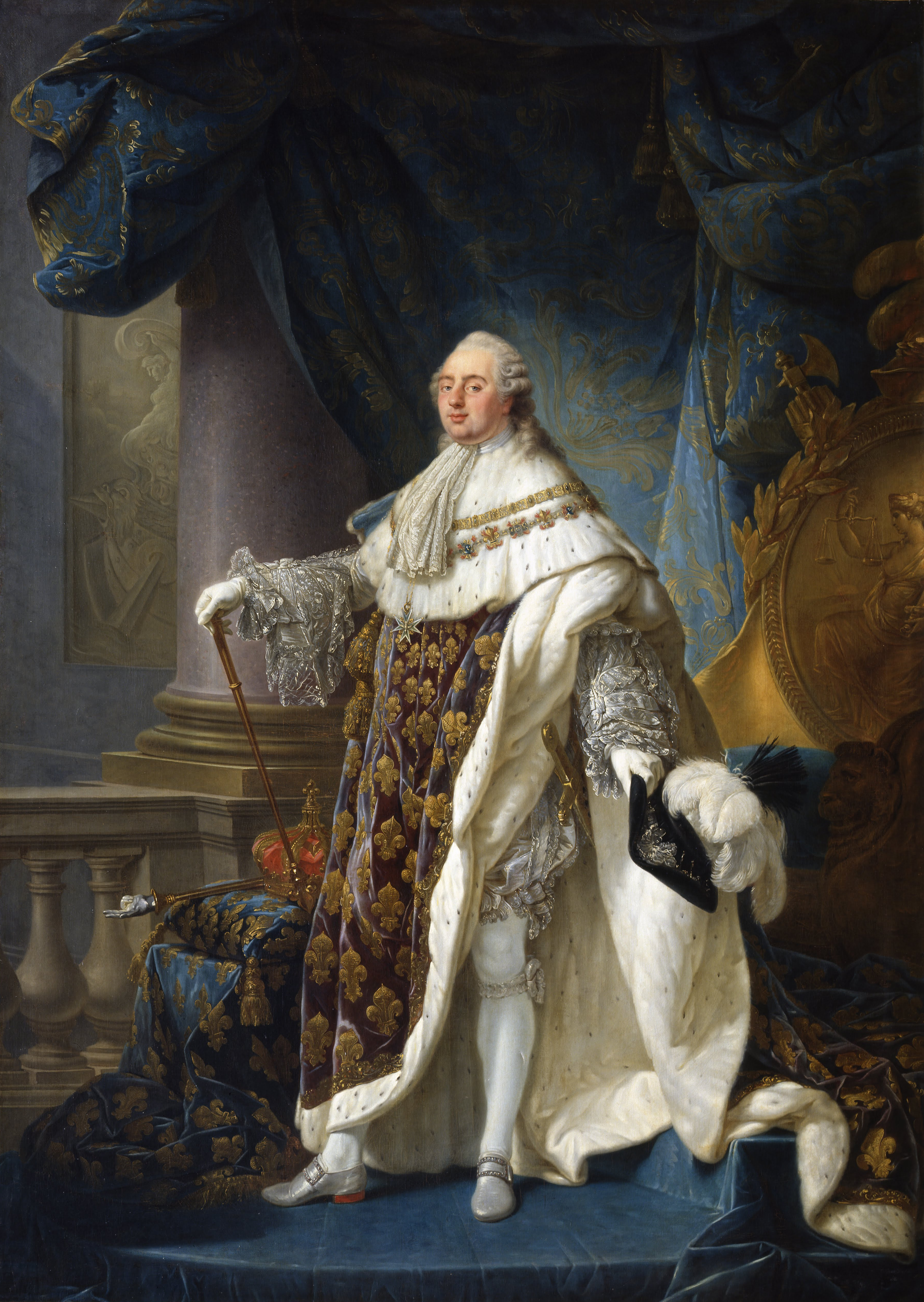
Louis XVI, roi de France et de Navarre (1754-1793), revêtu du grand costume royal en 1779
Louis XVI (23 August 1754 – 21 January 1793), also known as Louis Capet, was King of France from 1774 until his deposition in 1792, although his formal title after 1791 was King of the French. He was executed on the 21st of January 1793. His father, Louis, Dauphin of France, was the son and heir apparent of Louis XV of France. As a result of the Dauphin's death in 1765, Louis succeeded his grandfather in 1774.
The first part of Louis' reign was marked by attempts to reform France in accordance with Enlightenment ideals. These included efforts to abolish serfdom, remove the taille, and increase tolerance toward non-Catholics. The French nobility reacted to the proposed reforms with hostility, and successfully opposed their implementation; increased discontent among the common people ensued. From 1776 Louis XVI actively supported the North American colonists, who were seeking their independence from Great Britain, which was realized in the 1783 Treaty of Paris.
The ensuing debt and financial crisis contributed to the unpopularity of the Ancien Régime which culminated at the Estates-General of 1789. Discontent among the members of France's middle and lower classes resulted in strengthened opposition to the French aristocracy and to the absolute monarchy, of which Louis and his wife, queen Marie Antoinette, were viewed as representatives. In 1789, the storming of the Bastille during riots in Paris marked the beginning of the French Revolution.
Louis's indecisiveness and conservatism led some elements of the people of France to view him as a symbol of the perceived tyranny of the Ancien Régime, and his popularity deteriorated progressively. His disastrous flight to Varennes in June 1791, four months before the constitutional monarchy was declared, seemed to justify the rumors that the king tied his hopes of political salvation to the prospects of foreign invasion. The credibility of the king was deeply undermined and the abolition of the monarchy and the establishment of a republic became an ever increasing possibility.
In a context of civil and international war, Louis XVI was suspended and arrested at the time of the insurrection of 10 August 1792 one month before the constitutional monarchy was abolished and the First French Republic proclaimed on 21 September 1792. He was tried by the National Convention (self-instituted as a tribunal for the occasion), found guilty of high treason, and executed by guillotine on 21 January 1793 as a desacralized French citizen known as "Citizen Louis Capet", a nickname in reference to Hugh Capet, the founder of the Capetian dynasty – which the revolutionaries interpreted as Louis' family name. Louis XVI is the only King of France ever to be executed, and his death brought an end to more than a thousand years of continuous French monarchy.
-VIDEO :BASILIQUE SAINT DENIS PARIS
Description
 The old royal abbey of Saint-Denis, has marked the history and art in France! Indeed, it is home to a necropolis where lie 43 kings, 32 queens, 63 princes and princesses and 10 great servants of the kingdom. It is one of the main pieces of the Gothic art...
The old royal abbey of Saint-Denis, has marked the history and art in France! Indeed, it is home to a necropolis where lie 43 kings, 32 queens, 63 princes and princesses and 10 great servants of the kingdom. It is one of the main pieces of the Gothic art...
The church stands on the site of a Gallo-Roman cemetery, burial site of Saint-Denis, patron saint of Paris and the Seine-St Denis, first bishop of the capital of France. He died as a martyr around 250, with six other missionaries who had come to bring the Christian faith in Gaul, at Montmartre (Mount of Martyrs).
Legend said that he would have raised, would have picked up his head and walked to the location of the basilica before falling.
In the seventh century, Dagobert I, king of the Franks built a large abbey church and was the first king to be buried there. It was then that the Church became the burial of most of the kings of France. Among other residents, we can find the tombs of Henri II, Catherine de Medici, Louis XVII's heart.
 In 754, Pepin the Short was crowned king by the pope. His son Charlemagne built the new Carolingian basilica. In the early twelfth century, Abbot Suger, adviser to Louis VI and Louis VII, decided to enlarge the church giving birth to the first Gothic church in France.
In 754, Pepin the Short was crowned king by the pope. His son Charlemagne built the new Carolingian basilica. In the early twelfth century, Abbot Suger, adviser to Louis VI and Louis VII, decided to enlarge the church giving birth to the first Gothic church in France.
 Basilica of Saint Denis is the place of conservation of Regalia, objects used during the coronation taking place at the Cathedral of Reims : crown, scepter and sword.
Basilica of Saint Denis is the place of conservation of Regalia, objects used during the coronation taking place at the Cathedral of Reims : crown, scepter and sword.
However French History precipitated the royal abbey of Saint-Denis to its decline : the Hundred Years War, the religious wars, political unrest marked the decline. The tomb of Saint Louis, a goldsmith work, was destroyed during the Hundred Years War. The royal necropolis was also damaged during the Revolution : desecration of graves, breach of royal tombs... those which contained bodies were also thrown into the pauper's grave. The revolutionaries attacked the symbols of the monarchy, however, the church escaped total destruction.
Napoleon ordered the restoration of the building. Then Louis XVIII gave its role as a cemetery back to the abbey. Restoration work continued throughout the nineteenth century and were led by architects and Debret Viollet-le-Duc from 1846.

In 1862, the basilica had been classified as an historic monument.
Every year, in May and June, the Royal Basilica hosts many concerts at the Festival of Saint-Denis, and receives great musicians for concerts of classical, contemporary and popular music.
The church stands on the site of a Gallo-Roman cemetery, burial site of Saint-Denis, patron saint of Paris and the Seine-St Denis, first bishop of the capital of France. He died as a martyr around 250, with six other missionaries who had come to bring the Christian faith in Gaul, at Montmartre (Mount of Martyrs).
Legend said that he would have raised, would have picked up his head and walked to the location of the basilica before falling.
In the seventh century, Dagobert I, king of the Franks built a large abbey church and was the first king to be buried there. It was then that the Church became the burial of most of the kings of France. Among other residents, we can find the tombs of Henri II, Catherine de Medici, Louis XVII's heart.
However French History precipitated the royal abbey of Saint-Denis to its decline : the Hundred Years War, the religious wars, political unrest marked the decline. The tomb of Saint Louis, a goldsmith work, was destroyed during the Hundred Years War. The royal necropolis was also damaged during the Revolution : desecration of graves, breach of royal tombs... those which contained bodies were also thrown into the pauper's grave. The revolutionaries attacked the symbols of the monarchy, however, the church escaped total destruction.
Napoleon ordered the restoration of the building. Then Louis XVIII gave its role as a cemetery back to the abbey. Restoration work continued throughout the nineteenth century and were led by architects and Debret Viollet-le-Duc from 1846.
In 1862, the basilica had been classified as an historic monument.
Every year, in May and June, the Royal Basilica hosts many concerts at the Festival of Saint-Denis, and receives great musicians for concerts of classical, contemporary and popular music.
Author : Bérengère©
VERSAILLES - The marble staircase called "The Queen's staircase


Ornately decorated ceiling, Versailles Palace
| Marie Antoinette | |
|---|---|

Portrait by Élisabeth Vigée Le Brun, 1778
| |
| Queen consort of France |
Marie Antoinette ; baptised Maria Antonia Josepha Johanna; 2 November 1755 – 16 October 1793), born an Archduchess of Austria, was Dauphine of France from 1770 to 1774 and Queen of France and Navarre from 1774 to 1792. She was the fifteenth and penultimate child of Francis I, Holy Roman Emperor and Empress Maria Theresa of Austria.
In April 1770, upon her marriage to Louis-Auguste, Dauphin of France, she became Dauphine of France. She assumed the title Queen of France and of Navarre when her husband ascended the throne as Louis XVI upon the death of his grandfather Louis XV on 10 May 1774. After seven years of marriage, she gave birth to a daughter, Marie-Thérèse Charlotte, the first of her four children.
Within the kingdom of France, a growing number of the population eventually came to dislike her, accusing L'Autrichienne, "the Austrian woman", (a nickname given her upon her arrival to France by Louis XV's daughters, Mesdames de France), of being profligate, promiscuous, and of harbouring sympathies for France's enemies, particularly Austria, her country of origin. The Diamond Necklace affair damaged her reputation further. She later became known as Madame Déficit because France's financial crisis was blamed on her lavish spending and her opposition to the social and financial reforms of Turgot andNecker.
During the French Revolution, after the government had placed the royal family under house arrest in the Tuileries Palace in October 1789, several events linked to Marie Antoinette, in particular the June 1791 attempt to flee, and her role in the French Revolutionary War, had disastrous effects on French popular opinion: over a year later, on 10 August 1792, the attack on the Tuileries forced the royal family to take refuge at the Assembly. On 13 August, the family was imprisoned in the Temple. On 21 September 1792, Louis XVI was deposed and the monarchy abolished. After a two-day trial begun on 14 October 1793, Marie Antoinette was convicted by the Revolutionary Tribunal of treasonto the principles of the revolution, and executed by guillotine on Place de la Révolution on 16 October 1793.

The Queen's bedchamber
-VIDEO:Marie Antoinette (2006 film)_
Full Movie - Biography, Drama Movie - Kirsten Dunst, Jason Schwartzman Movie
The retelling of France's iconic but ill-fated queen, Marie Antoinette. From her betrothal and marriage to Louis XVI at 15 to her reign as queen at 19 and to the end of her reign as queen and ultimately the fall of Versailles.

The Lion Monument (German: Löwendenkmal), or the Lion of Lucerne, is a sculpture in Lucerne, Switzerland, designed by Bertel Thorvaldsenand hewn in 1820–21 by Lukas Ahorn. It commemorates the Swiss Guards who were massacred in 1792 during the French Revolution, when revolutionaries stormed the Tuileries Palace in Paris, France. Mark Twain praised the sculpture of a mortally-wounded lion as "the most mournful and moving piece of stone in the world."
From the early 17th century, a regiment of Swiss mercenaries had served as part of the Royal Household of France. On 6 October 1789, King Louis XVI had been forced to move with his family from the Palace of Versailles to the Tuileries Palace in Paris. In June 1791 he tried to flee abroad. In the 1792 10th of August Insurrection, revolutionaries stormed the palace. Fighting broke out spontaneously after the Royal Family had been escorted from the Tuileries to take refuge with the Legislative Assembly. The Swiss Guards ran low on ammunition and were overwhelmed by superior numbers. A note written by the King has survived, ordering the Swiss to retire and return to their barracks, but this was only acted on after their position had become untenable.
Of the Swiss Guards defending the Tuileries, more than six hundred were killed during the fighting or massacred after surrender. An estimated two hundred more died in prison of their wounds or were killed during the September Massacres that followed. Apart from about a hundred Swiss who escaped from the Tuileries, the only survivors of the regiment were a 300 strong detachment which had been sent to Normandy a few days before August 10. The Swiss officers were mostly amongst those massacred, although Major Karl Josef von Bachmann — in command at the Tuileries —was formally tried and guillotined in September, still wearing his red uniform coat. Two surviving Swiss officers achieved senior rank under Napoleon.

The queen's grand apartment at Versailles

Queen's Bedroom, Versailles

Room in the Grand Trianon, Versailles

Room in the Petit Trianon, Versailles

Salle des Gardes, Versailles Palace

A hall for the music in perfect Louis XVI style, built for Maria Antoinette

A private salon (The Cabinet Dore) of Marie Antionette

Chandelier


Chateau_Ve

Hall of Mirrors, Versailles

Chimneypie

Detail of the bed of Madame de Pompadour

Globe in Versailles

Le Petit Appartemen
Madam Pompadour'

Marie Antoinette

le petit théâtre de Marie-Anto

chambre dauphin, Palace of Versailles

Marie Antoinette

Marie Antoinette

Marie-Anto

Ostrich lamp, Versailles France


Hall of Mirrors_Versailles

Versailles

Versailles



chambre dauphin, Palace of Versailles

Versailles
-VIDEO: The French Revolution FULL MOVIE 1989
-VIDEO :Découvrez le château de Versailles [Documentaire] (VF)
-VIDEO :Discover Palace of Versailles [documentary] (en)
Versailles is a Franco-Canadian television series about the construction of Versailles Palace during the reign of Louis XIV that premiered on November 16, 2015 on Canal+ in France and Super Channel in Canada. A second season was already ordered ahead of the premiere. Filming for the second season will begin in January 2016 and its story will take place four years after that of the first season. The show will premiere in the U.S. on Ovation on October 1, 2016.
-VIDEO Versailles (UK, Season 1, 10 Episodes, 2015, TV Series)
-VIDEO Versailles (UK, Season 1, 10 Episodes, 2015, TV Series)

Reception of the Grand Condé at Versailles following his victory at Seneffe. Condé advances towards Louis XIV in a respectful manner with laurel wreaths on his path, while captured enemy flags are displayed on both sides of the stairs. It marked the end of Condé's exile, following his participat









No comments:
Post a Comment